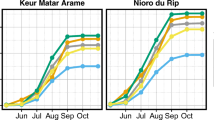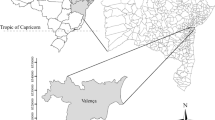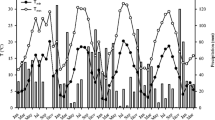Abstract
Early growth of some woody shrubs used in alley cropping were studied in the Buberuka Highland and Central Plateau region of Rwanda. The altitudinal ranges for the two agroecological zones are 1800–2400 m and 1500–1900 m respectively. First, early growth of Sesbania sesban (Sesbania) as affected by intercropped bean, potato, pea and wheat was studied. Second, effect of lime and manure applications on growth of Sesbania, Leucaena sp (Leucaena), Calliandra Calothyrsus (Calliandra) and Markhamia lutea (Markhamia) was investigated. Third, growth of Sesbania and Leucaena at selected locations were examined. Bean grown in association with Sesbania enhanced the growth of the shrub in the Central Plateau region. At both sites, growth of Sesbania was retarded by intercropped pea. Growth of Sesbania increased significantly during the dry season in June and July. Biomass and height after one years' growth of Sesbania were higher in the Buberuka than in the Central Plateau region. Growth of the shrubs is ranked as: sesbania > Leucaena > Calliandra > Markhamia in the Buberuka Highlands. Farmyard manure generally increased the growth rates of the shrubs. Calliandra and Leucaena were most responsive to liming. The response of Leucaena to liming decreased with manure application but no definite trend was observed for Calliandra, Sesbania and Markhamia. Sesbania and Markhamia were least influenced by application of lime. Their respective LRI's were 0.35 and 0.46. The average growth rates for Sesbania and Leucaena at selected locations ranged between 26.4–62.2 cm/month and 13.1–27.4 cm per month respectively.
Similar content being viewed by others
References
Hill GD (1970) Studies on the growth of Leucaena Leucocephala. Effect of clean weeding and nitrogen fertilizer on early establishment. Papua and New Guinea Agricultural Journal 22: 29–30
International Institute of Tropical Agriculture (IITA) Annual reports 1978–1982. Ibadan Nigeria
International Service for National Agricultural Research (ISNAR) 1983. Agricultural Research in Rwanda — Assessment and Perspectives. A report submitted to the Government of Rwanda, 235p
International Council for Research in Agroforestry (ICRAF) 1985. Field Station Machakos, Kenya. Status Report March 1985. p 17–20
ICRAF (1986) Field Station Machakos, Kenya Status Report March 1986. p 21–23
Institut des Sciences Agronomiques du Rwanda (ISAR) 1985. Soil Association map for the Ruhengeri Prefecture, ISAR, Rubona Rwanda
Kang BT, Wilson GF and Lawson TL (1984) La culture en couloirs — un substitut d'avenir á la culture itinerante. Technical Bulletin, IITA, Ibadan, Nigeria
Kang BT, Wilson GF and Sipkens L (1985) Alley cropping maize (Zea mays) and Leucaena (Leucaena Leucocephala Lam de Wit) in southern Nigeria Plant and Soils 63: 165–179
Kenya Woodfied Development Programme (KWDP) (1985) How to start a tree Nursery. The Beijer Institute, Nairobi Kenya, 16p
Ministry of Agriculture, Livestock and Forestry (MINAGRI) 1985. Premier seminaire national sur la fertilisation des sols au Rwanda. MINAGRI Kigali, Rwanda
Mongi HO and Huxley PA (ed) (1979) Soil Research in Agroforestry. Proceedings of an Expert consultation held at ICRAF in Nairobi. March 26–30, 1979. 584p
Nair PKR (1984) Soil productivity aspects of agroforestry. ICRAF Science and Practice of Agroforestry 1, 85p
Robins E (1985) Communal afforestation. A report on the results of the Socio-economic survey and status of the Afforestation Project. United States Agency for International Development (USAID), Rwanda 43p
Ross MS (1984) Towards a farm model for sustainable, low-input agroforestry systems in the humid tropics with reference to Indonesia. The International Tree Crops Journal, 3 (1984) 49–61
Westwood S (1986) Agroforestry component of the CARE Gituza Project. (Mimeog.) CARE Rwanda, 18p
Wilson GF and Kang BT (1981) Developing stable and productive biological cropping systems for the humid tropics. In Biological Husbandry. A Scientific Approach to Organic Farming. (B Stonehouse ed) pp 193–203. Butterworth London
Yamoah CF and Grosz R (1986) Linking on-station research to on-farm testing: the case of agroforestry and organic matter-based cropping systems for the Rwanda Farming Systems Improvement Project. In press (Agroforestry Systems)
Yamoah CF, Agboola AA and Wilson GF (1986) Nutrient contribution and maize performance in alley cropping Systems. Agroforestry Systems 4: 247–254
Young A (1984) Evaluation of agroforestry potential in sloping areas. A working paper —ICRAF (Kenya) n 27, 36p
Young A (1985) The potential of agroforestry as a practical means of sustaining soil fertility. ICRAF working paper n 34. ICRAF, Nairobi, Kenya 28p
Zimmerman T (1986) Agroforestry — a last hope for conservation in Haiti. Agroforestry Systems 4: 255–268
Additional information
Contribution from the University of Arkansas' USAID supported Farming Systems Research Program (FSRP) in Rwanda (USAID 696-0110), BP 625, Kigali Rwanda
Rights and permissions
About this article
Cite this article
Yamoah, C., Grosz, R. & Nizeyimana, E. Early growth of alley shrubs in the Highland region of Rwanda. Agroforest Syst 9, 171–184 (1989). https://doi.org/10.1007/BF00168261
Issue Date:
DOI: https://doi.org/10.1007/BF00168261




